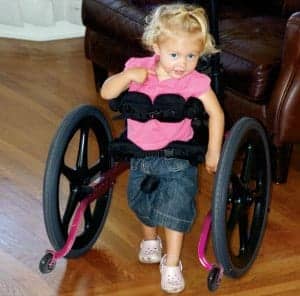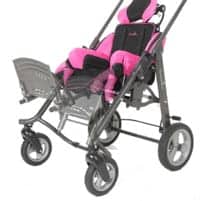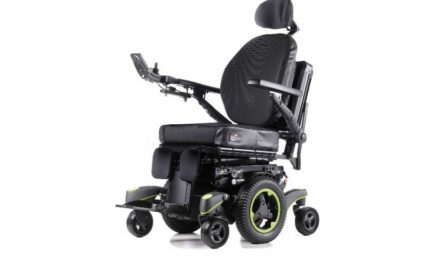
The essentially nonverbal child often begins to use words with others and develop friendships with the ability to self-propel.
From the moment a child is born, its parents begin the process of preparing the new life to one day live independently. The caregivers and community that form around the child strive to provide opportunities and support to promote self-confidence, independence, and the many other skills needed for the child to live happily and successfully as an adult. This process does not always follow a smooth forward path, but ultimately the goal of rearing a child to become independent remains unchanged as the child is propelled along by family, friends, the education system, and community.
For families who have children with special needs, the process of leading the child toward the goal of independence is not always well-defined. Whether the goal of independent living appears realistic or not, the challenge of a child’s physical disabilities—and in many cases, medical needs—does not allow the opportunity to look far into the future. It can become quite difficult to create and deliver strategies for promoting independence and self-confidence for the future when the child’s immediate needs for health and well-being may demand such a significant amount of attention day in and day out.
How does this relate to mobility devices? Actually, for many of these children, assistive and mobility technology may be the first keys that open doors to the world of independence—particularly for children who are nonverbal. For any child to develop socially, the ability to move independently and communicate with others is critical. For a child whose physical disabilities create barriers to movement, it becomes particularly important to equip that child with the ability to become mobile, thereby providing the opportunity to venture out, meet peers and extended community, and experience what it is like to have success and failure.
This is not a simple task for many children with motor challenges, and for those youngsters and their families, there may be many frustrations along the path toward independence. For example, the child’s first mobility device also may become the child’s first serious roadblock to independence. When children reach age 3 years, they typically enter some type of program conducted outside the home. This program often takes the form of a preschool curriculum located in a facility where other children with special needs may or may not be present. The parents or caregivers of the child with the physical disability will likely experience some anxiety and concern about sending the child to school for the first time, compounded by other concerns associated with the new environment such as health issues and feeding safety. This moment in the child’s life also may touch off fear among parents and caregivers about how the child will be perceived in the new environment. One factor that can affect this perception will be the decision about the mobility system the child will use—a decision the parents or caregivers will have to make as the child transitions into an external environment. Concern among parents or caregivers about how others will perceive the child may bias the choice toward a stroller-like device, since a stroller may seem familiar and is likely the mobility device used during the child’s younger years. Although a stroller may have once been functional and easy to transport, at this point in the child’s life it does little to promote independence, particularly as the child enters social settings.
A child who has the potential to self-propel but is restricted to the confines of a stroller misses vital opportunities for socialization. In a preschool setting, other children in class may often be engaged in lively activity around the disabled child, leaving them to participate only from a distance. If the disabled child is nonverbal, it becomes nearly impossible for that child to enter a conversation unless first approached by another child. It is therefore imperative in this setting that the same “first steps” afforded a toddler who does not have a physical challenge also be provided to a child who does have a physical disability. The disabled child may not able to propel a wheelchair initially at a speed as rapid as their scrambling peers, but how much more empowering is it for that child to simply be able to turn the chair around and face a teacher or another child who may be speaking from behind? How disempowering is it to a physically disabled child when a teacher calls a class to order and the child in a stroller must wait to join in the group until pushed by someone else? How can a child learn to make choices in life when they lack the opportunity to choose where to go in preschool? In many of these situations, the best solution may be to provide the child with a gait trainer or walker. Again, utilizing a device that provides the opportunity for a physically disabled child to be mobile and empowered can have a strong, positive effect on their development of self-confidence and ability to socially interact.
Although a physically disabled child may enter a preschool program while using a stroller, it is likely that as the child moves forward in school, they will move to a mobility system designed to offer the ability to self-propel. There is a risk, however, that a lengthy delay in moving a child to a self-propel device will allow a sense of “learned helplessness” to develop, which may seriously affect the child’s ability to use self-propulsion. As defined by Martin Seligman, PhD, “Learned helplessness is a condition of a human person or an animal in which it has learned to behave helplessly, even when the opportunity is restored for it to help itself by avoiding an unpleasant or harmful circumstance to which it has been subjected.” An interesting note also recorded by Seligman about his learned helplessness theory is the view that clinical depression may result from a perceived absence of control over the outcome of a situation. Many teenagers who have special needs seem to struggle with depression, even with significant developmental delay.
Perhaps the most vital function rehabilitation professionals can hope to cultivate among many physically disabled children is the ability to communicate. Even this, however, is affected by the lack of self-initiated mobility. It is well documented that development of communication occurs hand-in-hand with movement, and many who subscribe to this theory also believe children must be able to move independently in space to be able to communicate effectively with others. A child moves into another child’s space to initiate conversation. A child who is disempowered and nonmobile is not likely to initiate social interaction; however, when that child receives a self-propelling seating system, power wheelchair, walker, or gait trainer, the level of interaction often changes remarkably. Many clinicians who work in school settings have observed this phenomenon in which the essentially nonverbal child, spurred by the ability to self-propel, begins to use their words with others and develop friendships in classrooms that did not previously exist.
If the child is unable to propel in any way, the opportunity to statically stand in the home and classroom can at least provide the child with the opportunity for peer height interaction, which, in itself, is empowering. In addition, the child benefits from the positive effects of physical conditioning and cardiopulmonary challenge. The volume of vocalization may also improve, as some children improve depth of inspiration in standing compared to a seated position.
The new funding climate created by Medicare and other insurance companies has created a roadblock in securing self-mobility devices for physically disabled children. As seating systems must have a lifespan that is continually expected to be longer and cover generalized use in all environments, the compromise in assistive mobility choice must be made even more often. In the past days of “seating reality,” it was not abnormal to have a system that served the convenience of the family or caregivers as well as a system for the maximal functional needs of the child. The majority of clinicians who prescribed systems during those years continue to voice their opinion that the long-term utilization of two systems was actually more cost-effective in that it protected the primary system from damage, as families occasionally needed something lightweight to pack in and out of the car. Unfortunately, the second transport system was the first to be removed from funding. This is most obvious in cases for which a child needs a power chair but the family cannot afford the cost of a van, so the child’s needs are compromised with use of a manual system because only one device can be provided. Again, secondary systems are now very rarely funded. An alternative could be use of a power wheel assist system, either joystick or hub driven, which could be mounted on a folding chair. This would allow some children the ability to propel more rapidly or efficiently, while allowing the family to forego the purchase of a van for transport of a large power wheelchair. Funding for these models, too, can be difficult to obtain, and as a result, many of these children propel inefficiently and slowly while their peers zoom past them.
Operating in the era of safe transport also has complicated the landscape for obtaining the mobility devices needed by many children who have a physical disability. So much of the postural support that is put in place for the safety of a child in the bus may not be required during the remainder of that child’s “nontransport” time. Postural supports are rarely removable, however, and as a result, the child is “oversupported.” While the therapists and teachers diligently work on the acquisition of motor skills, the child’s rigid postural supports allow those skills to atrophy further.
We must continue to face the challenges associated with providing mobility devices that will lead children who have physical disabilities toward greater independence. As therapists, we understand our goal: to help develop self-confidence, positive social experiences, and independence to the greatest level of ability. To compromise even one degree of mobility can affect a child’s potential. Caregivers, clinicians, ATPs, and case managers must not become discouraged by the reimbursement system and compromise. In many ways, some of us in the rehabilitation profession have also learned to be helpless, which has led us to sometimes avoid challenging the system when we expect a funding request will be denied. Although we may not win approval for every case, each of these battles is worth fighting, and we must remain confident in ourselves as therapists and fearless in our efforts to help move children along the path of independence.
Catherine Mulholland, OTR/L, specializes in pediatric mobility and owns Pacific Rehab, Carefree, Ariz. For more information, contact .





